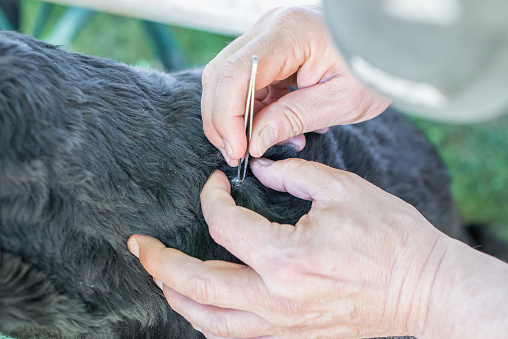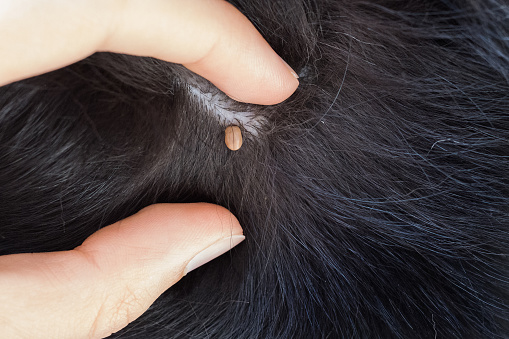
A nice warm weather, lush land and time to take your lovely paw friend on a long walk to the local park or a nice trip! Running, playing, sniffing around, and rolling in the grass are likely to be among your doggy’s favorite activities. Sometimes, this pleasant experience can be spoiled by tiny spider-like parasitic insects, namely-ticks.
Despite their small size, they can be dangerous for your paw friend due to the bacterial infections and diseases, such as Lyme disease, they can transfer. That is why it is important for pet parents to be able to recognize symptoms of ticks and know how to prevent their dogs from getting bitten.
What Are Ticks
Ticks are external parasites and more accurately-parasitic arachnids, that feed on the blood of mammals, birds, reptiles and amphibians. During the adult stage of their lives, the approximate length of their bodies is 3-5 mm, based on the sex and specie.
How Do Ticks Look When Attached to the Skin
When attached to your dog’s skin ticks look like bumps or raised moles, which makes them hard to distinguish. You should look closely to be able to recognize that these “moles” actually have a hard body, and six or eight legs, based on the life stage. Nymphs are ticks in their third stage of their life, that have 6 legs, while adult ticks (fourth stage) have 8 legs. If the tick has been attached to your dog’s skin for a while, its body should have been bloated due to the amount of blood it has sucked.
What Parts of the Dog’s Body Are Most Vulnerable
The areas around the dog’s head, neck, ears, under the collar, the toes, the tail, the groin, the eyelids and the armpits are body areas in dogs, that owners should check first. However, this does not mean that ticks can not attack other body parts.
When ticks get to your dog’s body, they search for the most suitable area to embed in, so you may recognize them and remove them before they attach to the skin and start blood feeding.
Signs in Dogs That They May Have Ticks
Even if you are unable to recognize a tick at a first sight, there are several signs, that may indicate that your dog has a tick:
1. Inflamed Skin
If a certain area on your dog’s skin became swollen, and red, it may have been inflamed due to the attached tick.
2. Excessive Licking on the Inflamed Area
If your paw friend excessively licks and bites at a certain area on his/her body, this might be caused by an embedded tick.
3. Shaking
If a tick has attached to your paw friend’s head or ears, he/she is likely to shake it due to the discomfort he/she is feeling.
4. Scabs
If you notice that there are scabs on your canine’s body, you should check these body areas for ticks.
5. Anemia
A type of anemia known as hemolytic anemia can be caused by ticks, as they break down red blood cells. Although cases of anemia, caused by ticks are rather rare, they still may occur, especially in smaller dog breeds.
6. Paralysis
Another symptom can be paralysis. It is also rare, but can occur due to the toxin included in the tick saliva, that is being injected into the dog’s body during blood feeding. This toxin attacks the nervous system and can cause temporary paralysis of the limbs or the entire body. Once you remove the tick, the normal function of the body and the limbs will return.
7. Tickborne Illness
According to the Centers for Disease Control and Prevention most tickborne diseases have similar symptoms such as: fever, fatigue, muscle aches and rashes.
8. Lyme Disease
Symptoms of Lyme disease in dogs can be: lethargy, loss of appetite, depression, fatigue, weight loss, and swollen lymph nodes. Kidney failure is a rare but possible consequence of Lyme Disease.
How to Remove a Tick from Your Dog’s Body
1. First, you should prepare tweezers;
2. Many people treat the bitten area with vegetable oil/alcohol/toothpaste if available, as the tick is likely to loosen their bite on the dog;
3. Let your dog calm down and gently part the fur around the area that will be treated;
4. Put the tweezers under the tick;
5. Make sure you have a good grasp, but be careful to not squeeze the tick’s body, as the head may remain stuck under the skin;
6. Twist the tweezers clockwise or anticlockwise until the tick gets out from under the skin;
7. Pull it away from the skin;
8. Once you remove the tick, we would recommend that you burn it;
9. Treat the area with antibiotic / antiseptic;
10. Wash your hands.
Tick Prevention
We would recommend that you take your dog to regular veterinarian checks and parasite control. Based on the area and the season parasite control may need to be conducted every month or every 2-3 months. Usually, tick control is in the form of pills, but there are also collars available, releasing repellent chemicals, when attached, that makes contact with the skin. These chemicals spread over the dog’s body and protect it within a certain period of time-usually several months.
It is important that you pay attention to your dog, especially while outdoor, provide regular checks after returning home and never neglect taking him/her for parasite control.













